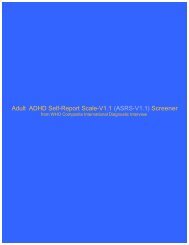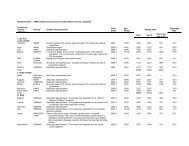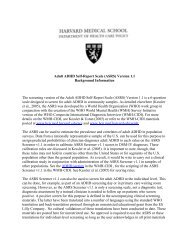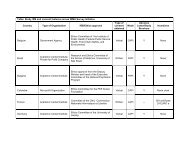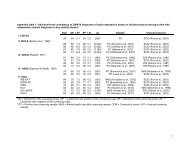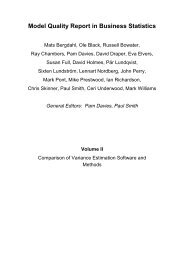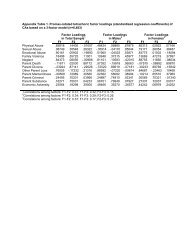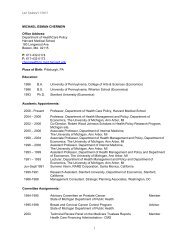Appendix Table - Harvard Medical School - Health Care Policy
Appendix Table - Harvard Medical School - Health Care Policy
Appendix Table - Harvard Medical School - Health Care Policy
Create successful ePaper yourself
Turn your PDF publications into a flip-book with our unique Google optimized e-Paper software.
<strong>Appendix</strong> <strong>Table</strong> 10. Current body mass index (BMI) among respondents with versus without DSM-IV/CIDI bulimia nervosa (BN) and bingeeating disorder (BED) in the NCSR surveyBN BEDNo eatingdisorderLifetime 12-month Lifetime 12-month% (se) % (se) % (se) % (se) % (se)I. Distribution of BMI< 18.5 (underweight) 3.4 (2.5) -- -- -- -- -- -- 2.0 (0.4)18.5-24.9 (normal) 31.8 (5.6) 15.3* (9.5) 21.1* (5.0) 19.0* (4.4) 36.7 (1.5)25 – 29.9 (overweight) 34.4 (9.1) 42.2 (13.4) 39.2 (7.6) 35.7 (10.2) 36.2 (1.2)30 – 34.9 (obese class I) 10.2 (4.4) 3.5*,** (3.5) 21.4 (6.4) 25.6 (7.4) 15.1 (1.2)35 – 39.9 (obese class II) 10.1 (4.7) 20.3 (13.4) 4.5 (1.9) 3.6 (1.9) 6.2 (0.7)40+ (obese class III) 10.0 (4.9) 18.7 (11.4) 13.9* (4.5) 16.2 (7.6) 3.8 (0.5)35+ (obese class II-III) 20.2 (5.5) 39.0* (14.0) 18.4 (4.5) 19.8 (7.6) 10.0 (0.8)30+ (total obese) 30.3 (7.4) 42.4 (14.3) 39.8 (7.4) 45.4 (10.5) 25.1 (1.5)II. Logistic regression of BN or BED (vs. No lifetime eating disorder) on BMI 1OR (95% CI) OR (95% CI) OR (95% CI) OR (95% CI)< 18.5 (underweight) 2.0 (0.4-9.3) -- -- -- -- -- --18.5-24.9 (normal) 1.0 -- 1.0 -- 1.0 -- 1.0 --25 – 29.9 (overweight) 1.1 (0.5-2.5) 2.8 (0.6-13.3) 1.9 (0.9-4.0) 1.9 (0.8-4.4)30 – 34.9 (obese class I) 0.8 (0.3-1.8) 0.6 (0.0-7.2) 2.5* (1.1-5.7) 3.3* (1.4-7.5)35 – 39.9 (obese class II) 1.9 (0.6-6.0) 7.8 (0.9-65.4) 1.3 (0.4-3.8) 1.1 (0.3-3.8)40+ (obese class III) 3.1* (1.1-8.9) 11.8* (1.7-81.3) 6.4* (3.0-13.9) 8.3* (2.9-23.7) 2 5 9.4 36.8* 45.9* 49.1*(n) (52) (16) (104) (51) (2,819)*Significant difference from respondents who had no lifetime eating disorder at the .05 level, two-sided test.**Significant difference between BN and BED at the .05 level, two-sided test1Based on a series of logistic regression models, each one comparing respondents with the eating disorder defined by the column headingwith respondents without a history of eating disorders



